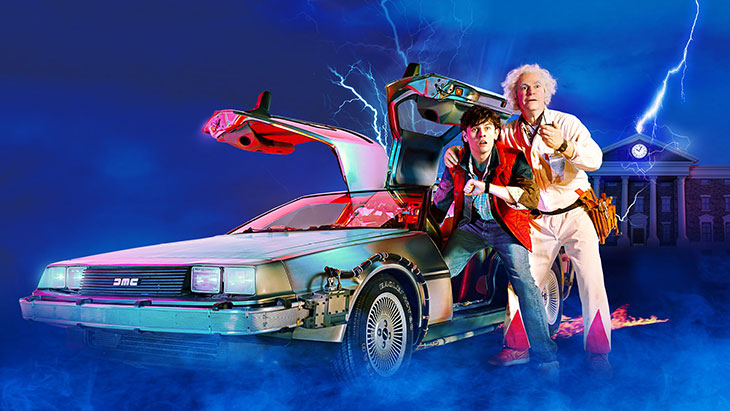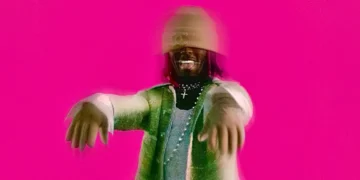
The DeLorean. 88 mph. Marty McFly. Doc Brown. These iconic images and characters are forever etched into the psyche of any ’80s film fan. When “Back to the Future” roared onto the big screen in 1985, it was an instant classic. Its blend of humor, heart, and high-flying adventure made it a box office sensation and cemented its place in cinematic history. Fast forward (or should we say, time travel?) to the present, and the timeless tale has found its way to the Broadway stage.
ART
The Winter Garden Theater is currently home to an electrifying blend of the past meeting the future – “Back to the Future: The Musical”. Directed by Tony Award-winning John Rando, and with a musical score composed by the esteemed Alan Silvestri and Glen Ballard, the show boasts not just a unique storyline but an incredible cast and crew. Casey Likes steps into the iconic shoes of Marty McFly, while Roger Bart embodies the eccentric genius of Doc Brown. Yet, amidst the glittering constellation of talent, two elements stand tall and unmatched — the DeLorean DMC and the production’s revolutionary scenography.
Welcome to the world of “Back to the Future: The Musical.”
Marty McFly, a character that has been etched into cinematic folklore, finds himself transported back to the era of poodle skirts and rock ‘n’ roll – 1955, courtesy of a time machine ingeniously crafted by the ever-quirky scientist, Doc Brown. However, a slight mishap alters history, and Marty must race against time, quite literally, to mend the present, escape the trappings of the past, and journey back to his future.

Arguably the most awaited element in this Broadway adaptation is the DeLorean DMC. When the car hits 88 mph and blazes a trail through time, audiences are treated to a multi-sensory spectacle. The Winter Garden Theater saw the unveiling of a life-size replica of the DeLorean, and its magnetic presence.
With its gull-wing doors and stainless steel exterior, the DeLorean was always more than just a car. It was a character in its own right. On Broadway, it’s taken on an even more magical quality. Instead of being limited by real-world physics and mechanics, the stage version employs a combination of special effects, projection mapping, and state-of-the-art animatronics to bring the vehicle to life. The time-travel sequences are a culmination of mechanical choreography, immersive projections, and well-timed theatrical elements. It’s not merely a prop but a live spectacle. The thrill of seeing it “in action” is an unparalleled experience.

Vibrant lights flash, smoke billows, and surround sound vibrates through the seats, immersing viewers in the sensation of time travel. But perhaps the most striking innovation is the vehicle’s ability to “hover” above the stage, thanks to concealed rigging and strategic lighting, paying homage to its flying counterpart from “Back to the Future Part II”.
Adapting a movie’s various settings for a stage production, especially one as varied and intricate as “Back to the Future,” presents unique challenges. Just as the DeLorean transitions from 1985 to 1955, so too does the world around it. The scenography is a masterclass in design, innovation, and sheer theatrical prowess. Scenes morph and shift with a fluidity that is almost cinematic, transporting audiences from the buzzing streets of 1980s Hill Valley to the quaint, picturesque town square of the 1950s.

From Marty’s skateboard chase to the iconic “Enchantment Under the Sea” dance, the scenography mirrors the car’s dynamism. Sets aren’t just backgrounds; they’re living, breathing extensions of the narrative, complementing the DeLorean’s antics with their own form of visual storytelling. Every backdrop, projection, and prop is meticulously designed to immerse, astonish, and take viewers on a roller-coaster through time.
Detailed miniatures, combined with high-resolution projectors, expand the depth and scale of each scene, allowing for the vastness of Hill Valley’s town square to coexist with the intimate interiors of Doc Brown’s lab. One particularly mesmerizing scene is Marty’s skateboard chase in 1955. Using a mix of practical effects and digital projections, Marty appears to skate around the town square, evading Biff and his gang, all while the scenery dynamically shifts around him.

“Back to the Future: The Musical” is more than just a nostalgic trip down memory lane; it’s a reinvigorated and innovative retelling of a beloved tale for a new generation. Its blend of stellar performances, unmatched musical scores, and of course, the DeLorean’s time-bending escapades, has made it a standout on Broadway. The accolades it has garnered, including the prestigious Olivier Award for Best New Musical, the Broadway World Award for Best New Musical, and four WhatsOnStage Awards, testify to its brilliance and the resonating impact it has on audiences. As the curtain falls and the DeLorean speeds off, one thing is certain: this production has truly made its mark in musical theater history.



















